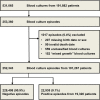Prevalence and Mortality Associated with Bloodstream Organisms: a Population-Wide Retrospective Cohort Study
- PMID: 35254101
- PMCID: PMC9020345
- DOI: 10.1128/jcm.02429-21
Prevalence and Mortality Associated with Bloodstream Organisms: a Population-Wide Retrospective Cohort Study
Abstract
Bloodstream infections (BSIs) represent a substantial mortality risk, yet most studies are limited to select pathogens or populations. The aim of this study was to describe the population-wide prevalence of BSIs and examine the associated mortality risk for the responsible microorganisms. We conducted a population-wide retrospective cohort study of BSIs in Ontario in 2017. Blood culture data was collected from almost all microbiology laboratories in Ontario and linked to data sets of patient characteristics. For each organism, we determined the prevalence and crude mortality risk, and using logistic regression models, the adjusted odds of 30-day mortality was calculated relative to patients with negative blood cultures and matched patients without blood culture testing. From 531,065 blood cultures, we identified 22,935 positive BSI episodes in 19,326 patients, for an incidence of 150 per 100,000 population. The most frequently isolated organisms were Escherichia coli, Staphylococcus aureus, coagulase-negative staphylococci, Klebsiella species, and Enterococcus species with 40.2, 22.4, 12.1, 11.1, and 7.1 episodes per 100,000 population respectively. BSI episodes were associated with 17.0% mortality at 30 days. Compared to patients with negative cultures, the adjusted 30-day mortality risk for positive BSIs was 1.47 (95% confidence interval (CI), 1.41 to 1.54) and compared to matched patients without blood culture testing was 2.62 (95% CI, 2.52 to 2.73). Clostridium species were associated with the highest adjusted odds of mortality compared to that of negative cultures (adjusted odds ratio, 5.81; 95% CI, 4.00 to 8.44). Among high incidence pathogens, Staphylococcus aureus had the highest odds ratio of mortality (adjusted odds ratio, 2.14; 95% CI, 1.94 to 2.36). BSIs are associated with increased mortality risk, varying across organisms.
Keywords: bacteremia; bloodstream infection; population; surveillance.
Conflict of interest statement
The authors declare no conflict of interest.
Figures



References
Publication types
MeSH terms
LinkOut - more resources
Full Text Sources
Medical

